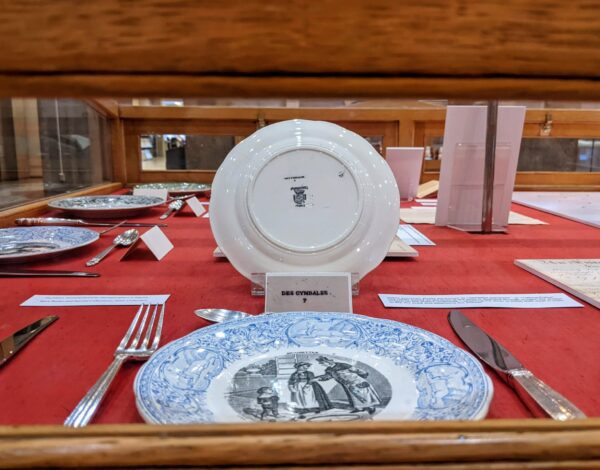As of Feb. 1, McGill’s McLennan Library has become home to Food for Thought: Riddles and Riddling Ways, the newest exhibit presented by the Rare & Special Collections, Osler, Art, and Archives (ROAAr) branch. The exhibit—dubbed The Riddle Project—was curated by English professor and associate dean of McGill Library Nathalie Cooke and her team.
Centring on “the intersections of culinary and riddling practices” in North America and the United Kingdom during the 18th to 20th centuries, the display features a collection of joke-books and riddles printed on dishes and menus. This playful and charming exhibit invites students and faculty into the library with its beautiful, old manuscripts and riddling items that remind the observer of the joys and bizarre traditions of communal meals during the Age of Enlightenment.
The discovery of a collection of menus that describe dishes through riddles, called “Enigmatic Bills of Fare” prompted the idea for The Riddle Project. These items were initially made with the intention to liven up dinner parties for centuries using riddles and puzzles. A “blog post” accompanies each item in the collection explaining the object’s origins and elaborating upon its connection to the larger purpose of the exhibit.
Upon first glance, the collection appears rather insignificant, with only a dozen small objects on display. But upon future inspection, it becomes apparent that each object is multifaceted: They not only perform their intended use, but also act as entertainment and as conversation starters. For example, the exhibit boasts an impressive collection of plates dating back to the 1850s. Though at first the plates appear rather boring, a closer look reveals that what is actually printed only on the front is a riddle, with the answer written on the back. One plate depicts an image of two men, one dressed in regular clothes and the other in a strange wizard costume. The riddle at the bottom on the plate reads (in French) “What is the day of the year that no one has ever seen?,” while the underside reads “tomorrow.”
Several manuscripts featured in the exhibit contain pages of cartoon-like illustrations accompanied by short riddles that are a treat for any fan of vintage cartoons and comic books. The colourful drawings and images stand out against the black and white texts. The catch is that all the riddles have a food-related answer. The exhibit maintains the perfect balance of hilarious, colourful riddles and games, as well as explanations to hold the viewer’s attention as they make their way through the collection.
Though it is being housed in the library, the collection is also available online. Moreover, the online version contains a myriad of interactive world maps that show the viewer where and when many of these objects originated.
Food for Thought: Riddles and Riddling Ways breaks bread with riddles in order to find their connection to shared culinary history. Filled with whimsical figures painted on plates and into books, these artifacts come to life as the viewer unravels the mystery behind their hidden games. The exhibit solves the puzzles of early 18th-19th century riddles and may just even inspire your next dinner party.









